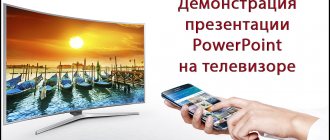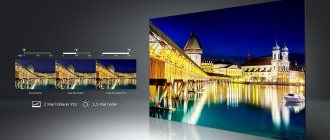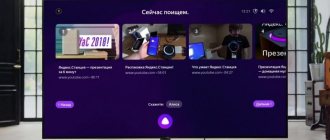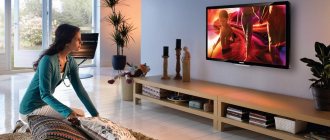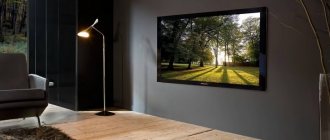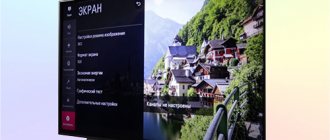LCD TVs used fluorescent lamps to backlight the screen, but this technology is now considered obsolete. With the advent of LCD panels, LED backlighting began to be used - Direct LED or Edge LED.
Each technology has its own technical features, but they are effective and make it possible to reduce the thickness of the TV case. What are the pros and cons of these types of backlights on TVs - this will be discussed in the article.
What are the advantages of an LED TV?
The LED type of display backlight increases the contrast.
LED (Light-emitting Diode) is a type of screen backlight whose matrix consists of liquid crystals. The molecules of this substance are characterized by the property of fluidity, while they have an ordered structure in the form of a crystal lattice.
In the matrix, the crystals are located among the electrodes. When voltage is applied to the electrode, the molecule of the substance changes its position, allowing light of a certain wavelength to pass through (which affects the color).
But first, the waves are “processed” by polarizing filters: one is responsible for rays in the horizontal plane, the second – in the vertical. This work is done for each individual pixel.
What is LED backlighting on a TV - this is the light source responsible for the appearance of the picture on the screen. It is installed in different ways, so there are two technologies: Direct LED and Edge LED.
What advantages does the LED type of display backlight provide for the consumer:
- Contrast increases (dark and light colors are displayed more accurately);
- color rendering improves;
- the backlight has low energy consumption;
- TVs have become thinner and lighter;
- the picture has become clearer, as the pixel afterglow time has decreased;
- the matrix is made without the use of mercury, which indicates its environmental friendliness.
It’s difficult to answer right away which TV backlight is better – Direct LED or Edge LED. To do this, it is necessary to study the technical intricacies of each technology.
Tips for choosing
LED devices have become popular. After all, LED TV - what does it mean? This is high quality, convenient and comfortable to use. The advantage of an LCD TV is LED backlighting; all LED models have it. But sometimes you have to pay extra for design features and additional features. What should you pay attention to when choosing an LED TV model?
First of all, you need to decide which diagonal is best to choose. The stores offer a huge selection of different models from 19 to 58 inches. Sometimes it is not very common to calculate in inches and you have to select the size in centimeters, that is, from 48 to 147 cm. The correct choice of diagonal depends on the size of the room where the TV will be installed.
Edge LED
LED blocks must be technically correct and accurately placed.
“Edge” is translated from English as “corner”. This is where the peculiarity of this type of backlight comes from - the LEDs are located along the edges of the inside of the screen (on the right or left side). The technology is affordable, which has made it popular.
The strip on which the LEDs are placed is attached to the side surfaces of the matte diffuser, so the light background is more uniform.
Thanks to the end arrangement of the diodes, it was possible to reduce the thickness of the TV body. At the same time, eye strain is further reduced.
But, LED blocks must be technically correct and accurately placed. If you make a mistake, flares will appear on the screen - light spots that appear as a result of uneven glow.
What Edge LED is on a TV is clear, but what are the advantages of this technology:
- the matrix has become more compact. The side placement of the LEDs made it possible to reduce the overall thickness of the panel;
- high brightness, which ensures comfortable reading of information from the screen.
There are also disadvantages:
- glare may appear. In new TVs, in order to distribute reflected light more evenly over the surface of the matrix, they make a reflective surface with a matte finish. But this solution increases the price of TV;
- Compared to Direct LED, Edge LED consumes more electrical energy.
With edge lighting, the picture in the center of the display will appear darker. In the manufacture of many TV models, local dimming tape is used, which reduces brightness differences.
Main characteristics
Screen resolution . Determined by the number of pixels that form the image in width and height. The higher this parameter, the clearer the image and the more different details you can see on the screen.
LED-TVs mainly have Full HD (1980x1920 pixels) and HD Ready (1366x768 pixels) resolution. These are the most popular video formats at the moment. Some premium models have 4K UHD resolution (3840x2160 pixels).
Almost all 4K UHD TVs support HDR. This is an extended dynamic range format that allows you to depict a picture as close to reality as possible.
Screen covering . There are matte and glossy. With a matte finish, the image is softer. Viewing angle is limited. There is no glare when exposed to sunlight. If the coating is glossy, then the picture on the screen is very bright and contrasting. Visibility becomes poorer in bright sunlight.
Functional connectors . Usually there are standard ones: HDMI output, Ethernet output and USB connector for watching video from a flash drive or hard drive. The latest models have a D-sub video port. It involves connecting a computer to a TV.
Sweep frequency . An indicator of how many frames of a film are shown per second. It is measured in Hertz and can reach values up to 960 Hz. For 3D TVs, the frequency can be even higher. The recommended range of values so that the image does not blur and pictures do not overlap one another is 100−200 Hz.
Direct LED
To increase uniformity, a light diffuser is placed between the screen and the diodes.
To understand what Direct LED is on a TV, an English-Russian dictionary is useful. The word “direct” is translated as “straight,” which was the engineers’ idea. In a TV with such a screen, LED backlighting is installed not on the sides, but in the area of the back wall, behind the matrix, along the entire area, but at a certain interval.
The technology allows you to evenly distribute the light flux, making it uniform over the entire surface of the display. To increase uniformity, a light diffuser is placed between the screen and the diodes.
The number of diodes and the principle of their arrangement remains at the discretion of the equipment manufacturer. A common property of the “backlight” is the increased thickness of the housing, since additional space is required for the LED block.
The type of TV screen with Direct LED backlight has the following advantages:
- uniform distribution of light over the entire area of the matrix, which is determined by the location of the LEDs;
- the glow is uniform, so there are no glares;
- the LED block is located at the rear, which increases the maintainability of the equipment;
- less energy consumption.
Minuses:
- increased thickness of the TV case;
- lower brightness than Edge LED.
Direct-backlit TVs currently being produced produce contrasting, bright pictures with deeper blacks.
True, in order for the black to be truly “deep”, it is necessary to implement technology that turns off the LEDs in those places where this color is displayed.
This is typical only for expensive models. In simpler panels, the backlight works constantly, which is why it is not possible to create a “perfect black” color.
Additional features
DVB-T . Digital television standard. Allows, in addition to analogue cable and terrestrial television, to connect satellite television.
Volumetric 3D image . Using this option, you can view 3D images with active or passive 3D. It is necessary to take care of special glasses.
Smart TV . Allows you to connect and use the Internet. The connection occurs via the WiFi module. Connection via network cable is possible. Some TVs allow you to build in an additional router. With Smart TV you can play videos from the Internet, play games, listen to music, and search for information.
What to choose
Which TV backlight is better – Edge or Direct? Anyone who watches TV, connects a set-top box to it, wants to enjoy a bright, contrasting picture. Each technology has both strengths and weaknesses:
- Edge-LED. This is high brightness and rational direction of the light flux, which reduces eye strain. But due to the low contrast, the image appears slightly blurry. And it’s better not to install the TV at an angle - the light diffuser can easily be damaged. The Edge backlight is suitable for users who spend a lot of time looking at the screen;
- Direct-LED. Illumination across the entire panel area provides high image clarity and contrast. TVs with Direct LED are thicker, but despite this, they are chosen by demanding viewers and game fans.
Which type of backlight to choose depends on personal preference. If you need a really thin TV - Edge. If thickness doesn’t matter, but you want to enjoy a good image – Direct. It happens that a manufacturer uses good technology, but does not implement it in the best way, so it is still better to come to the store and see with your own eyes how everything looks.
OLED TVs: brightness and color at their best
TVs with OLED screens have already reached stores, and developers have rushed to release new models with concave displays. Last year, LG planned to introduce a 55-inch OLED TV to the market, but it only went on sale this summer. In Russia, model 55EM9600 and its improved analogue 55EM9700 will cost the buyer 500,000 rubles. In addition, the device is sold in Europe, the USA and some other countries.
Advantages of OLED TVs: it is not a type of backlight, but a different technology
- accurate color reproduction
- greater brightness margin compared to other technologies
- high contrast compared to LCD models (another imaging technology).
- the absence of an LCD matrix and LED backlight - their place was taken by a matrix made of light-emitting organic diodes.
Samsung and LG independently developed OLED TVs with concave screens (Curved OLED). This design is designed to minimize distortion at the edges of the image and increase detail. New items are still available in limited quantities in South Korea, the USA and some European countries. The 55-inch model Samsung KN55S9C is priced by the manufacturer at $9,000 (300,000 rubles).
Of particular interest is also Multi-View technology, implemented in many models of OLED TVs with both flat and concave screens. Due to their extremely fast response time, such devices allow you to simultaneously show two or four programs in high definition (Full HD) or two different films in 3D format. Shutter glasses are used to separate the image. Each viewer can use the controls located on the glasses to select an individual program for viewing. At the same time, thanks to the built-in headphones, playback of the soundtrack corresponding to the film is ensured.
Determination of non-working LEDs
Previously, we looked at the process of disassembling the TV, now let's proceed directly to the repair. To replace the LEDs in the backlight, carefully unclip all fasteners and then remove the plastic frame. We remove the scattering films to open access to faulty elements.
The structure of the LED backlight directly depends on which particular model of television equipment we are talking about. For example, for LG 32LB582V there are three rows of LEDs for 6 pieces. Model 32LN541U has one more diode in each row.
Television equipment that uses this lighting technology is characterized by a series connection of diodes, so if only one element burns out, then absolutely the entire system will fail.
If the driver breaks down, the entire system will lose power. If only one diode burns out, then there will be voltage, but there is no proper lighting. The circuit is open. Therefore, you need to change the faulty LEDs of your LG TV for correct viewing.
Approximately, the backlight system has about 18 diodes; voltage measurements showed that 140 V is supplied without loading, which means that each element separately accounts for approximately 7.8 V.
Why are all these calculations needed? The voltage level of each strip and the total load allow you to calculate the power of the LEDs used. Finding a faulty system element is extremely difficult. If the fasteners are not burnt, then you will have to recheck absolutely all the diodes one by one.
Replacing LEDs
Replacing the backlight of an LG TV yourself is extremely difficult, and it is possible that you will encounter certain difficulties. Let's assume that during the diagnostic process you were able to identify a couple of damaged diodes. Purchasing a strip of new light bulbs is very problematic. Service centers do not supply these parts, so the only option is to purchase from the manufacturer. It is clear that you will have to wait a very long time for delivery, not to mention the cost.
To avoid buying a strip, you should replace the LEDs in LG LED TVs one by one. You can buy it on the market. Mostly they sell already soldered parts, but that’s okay, the main thing is that they work.
Remember that absolutely all planks are fixed with double-sided tape. Therefore, they need to be heated with a soldering hair dryer to loosen the fixation of the adhesive tape. Fix the LED strip in a special holder. Warm it up with a hairdryer from below, eventually the tin will melt. This is how the broken part is removed. Soldering is carried out in a similar way; this is the only way to change a part without damaging it.
Remember that in the factory, absolutely all lenses are attached with a compound, therefore, be extremely careful when dismantling them. Each of them will have to be installed in its place. So as not to disturb focus.
There is one more subtlety: it is possible that you will come across LEDs with a large negative platform, therefore, the positive one will be smaller. Trim the contact point to solder the diode.
If the paint is slightly damaged, that's okay. The remaining structural elements are soldered using a similar principle. As for the lenses, they need to be glued using superglue.
LED Screen Calibration
Calibration of LED screens is a detailed software adjustment of all elements of the system. These actions are performed in the following situations:
- when assembling a new screen;
- after replacement of spare parts or repairs;
- after a long period of equipment downtime;
- upon expiration date specified by the manufacturer;
- after exposure to vibration, weather conditions, physical damage;
- at high humidity;
- when color rendering deteriorates.
Preface
The backlighting of the first LCD TVs was made using fluorescent ( CCFL ) lamps. This backlight has proven itself to be the best, however, it is in many ways inferior to LEDs in terms of brightness, backlight dynamics and energy consumption.
If a powerful inverter is needed to ignite CCFL lamps, then for LEDs a small driver is needed, the main function of which will be to control the current and voltage to power the LEDs.
How to connect everything
In the box with the device you will find: clear instructions in English with pictures, a roll of RGB diode strip selected when ordering, the backlight control unit itself, an external power supply and cables for connection.
1. To begin, apply the tape to the back cover of the TV as close to the edge as possible around the entire perimeter.
2. Pay special attention to the corners; you can cut the tape and solder it at the joints or simply bend it carefully.
3. After this, connect the tape to the power supply according to the diagram.
4. Connect the logical cable to the control unit.
5. Connect the control unit to a free USB port on your set-top box.
6. Install the Ambient light Application for Android from Google Play. The utility is paid, costs 199 rubles .
7. We launch the application and can immediately check the operation of the tape by turning on the glow mode with one color or a random effect.
8. After this, we go to the application parameters, in parallel we count the number of diodes in the vertical and horizontal sections of our backlight.
9. We configure the corresponding parameters in the settings: set the number of diodes vertically and horizontally, the direction of the tape (clockwise or counterclockwise),
10. The LEDs Bottom Gap setting allows you to set an inactive area under the TV stand, and the First LED Offset parameter allows you to select the location of the first diode for different options for gluing the tape.
11. Below you can configure the screen refresh rate, the color capture area and the quality of the reproduced effects (the frequency of tape color changes).
After entering all the parameters, you can check the correct operation of the backlight in Screen Capture Mode .
▣ For correct operation of the backlight in different applications, we recommend using a third-party player – Vimu Media Player. In its settings, you need to activate the Output video to texture .
▣ To work when watching IPTV, use OTTPlayer with the Decoder media player .
▣ Viewing YouTube with background lighting is possible through the Smart YouTube TV application.
In games, the feature will work without additional settings and dancing with a tambourine.

